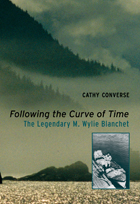Meet Muriel W. Liffiton and M. Wylie Blanchet
Copyright 2006 Thomas Liffiton
A copy of this article is available through download in the Archives section of this site. The WriterConsider this a mere introduction to Muriel Liffiton, a person to be known and enjoyed through her own writing and through the articles already written and filled with memories of friends and relations. While to many she is known only as M. Wylie Blanchet or as Muriel Blanchet, on May 2, 1891, in Montreal, Canada, she was born Muriel Wylie Liffiton. However, she wrote under her married name, having married Geoffrey Orme Blanchet in 1912. So it has been as M. Wylie Blanchet that she has earned a place in Canadian literature as the author of The Curve of Time, an unusual book of travel and adventure.
After being widowed at an early age in 1926, Muriel Blanchet raised her five children on Vancouver Island in Canada’s British Columbia. For several summers Muriel, her children, and the family dog set off in a twenty-five foot motor boat, the Caprice, to explore the waters between Vancouver Island and the rugged Canadian mainland. They were on their own, with Muriel as captain, anchoring in secluded coves to tramp the wilderness, examining architecture and burial grounds in deserted native villages, and meeting the region’s various human and animal inhabitants, a hermit, a whale, a cougar, bears. Muriel wrote about their journeys, and was successful in having articles published in magazines such as Blackwood’s Magazine and the Atlantic Monthly. In 1962, the year Muriel died, Blackwood & Sons of Edinburgh, Scotland published The Curve of Time, which described several summers of the family explorations. In 1968, Gray Publishing in Canada printed a second edition of The Curve of Time, and since then interest in the book has continued to grow. In 1982, Harbour Publishing printed A Whale Named Henry, a children’s story Murial wrote for her family in the 1930s.
Seal Press is the current publisher of The Curve of Time, and that edition contains a photograph of Muriel, a photograph of The Caprice, and a biographical sketch of the author. In 1999, Contemporary Authors, a reference book found in most libraries, included a biographical sketch of Muriel and summarized book reviews written about The Curve of Time. Both biographical pieces are sparse with details of Muriel’s life, as is The Curve of Time itself. In her own book Muriel reveals her character and her personality as she braves a treacherous channel or is fearful for her children, but she declines to share the who, what, and whens of her life. She tells nothing of her parents, of her youth, and refers obliquely to her husband’s death. Some of the reviews of Muriel’s book remarked on the absence of specifics, the lack of names and dates, but Muriel was the writer, and she chose what to include and what to leave out. It is exactly her choice of words, along with her wise and competent tone, that naturally leaves the reader wanting to know more about Muriel the person. In that, The Curve of Time and Contemporary Authors disappoint, failing even to reveal that M. Wylie Blanchet was born Muriel Liffiton.
For the who, what, whens of Muriel’s life, the reader must go to “Capi Blanchet,” an article written by Edith Iglauer and published by a local British Columbian magazine in 1979. Iglauer, an accomplished writer herself, interviewed Muriel’s children and neighbors to get those personal, behind the scenes details of Muriel’s life. “Capi” was republished in 1991, as part of an Iglauer collection, The Strangers I have Met, which remains in print today. In 1985, Rosemary A. Joy, a relation, privately published The Genealogy of John Gray Goodall Snetsinger, which includes information on Muriel and her parents. Muriel’s mother, Carrie, was John Snetsinger’s daughter, and Joy’s work identifies exactly who was related to whom, and when they were born. She also has several photographs of Muriel’s parents, siblings, and children. The third and last published work on Muriel is Ruby Andrew’s article, “Sailing The Curve of Time,” published in the 40th Anniversary edition of Beautiful British Columbia in 1999. Andrew interviewed Muriel’s neighbor and publisher, providing some insight into the publication history of The Curve of Time. Of special interest are thirteen photographs of Muriel and family during The Curve of Time years. Unlike the jarring leap a fiction reader makes from imagination to seeing characters in a film, these photographs of the Caprice, of the Indian villages, and of Muriel and her children are the real thing.


